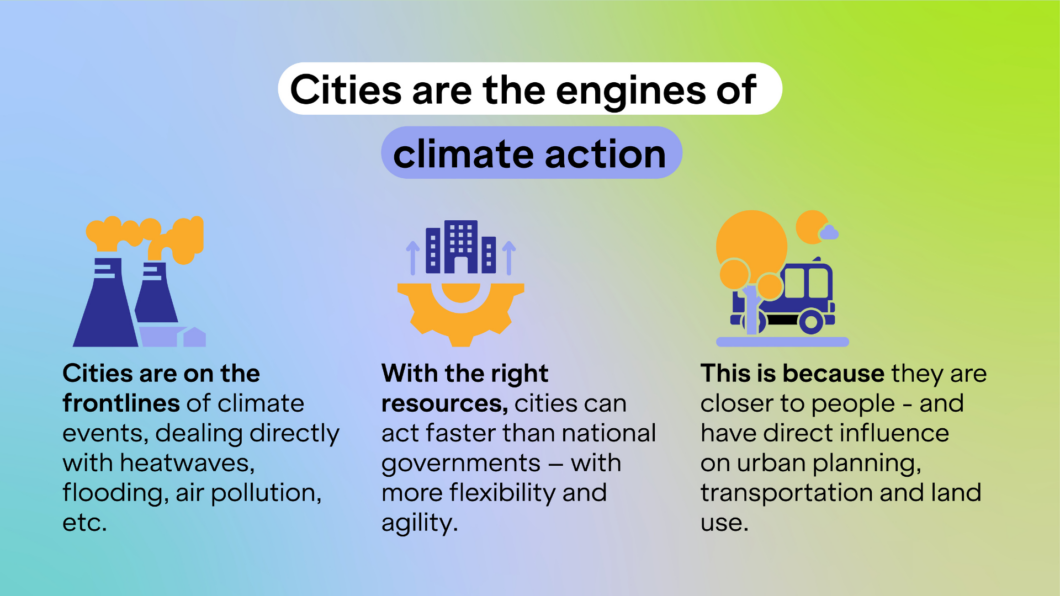This expert comment is co-authored with our partner Red de Innovación Local – and can be read in Castellaño on their site +Comunidad.
Cities in Latin America and the Caribbean account for more than 80% of the region’s greenhouse gas emissions, according to data from the UN and the Inter-American Development Bank. This phenomenon is driven by rapid urbanization, which has led to an uncontrolled expansion of transportation, industry, and deforestation. Additionally, these cities house over 80% of the regional population, making them key points for implementing effective solutions to address climate change.
However, the challenge is even greater: cities are increasingly exposed to extreme phenomena such as heatwaves, floods, and droughts, which affect millions of people.
Against this backdrop, Red de Innovación Local, a regional actor working closely with local governments across Latin America, joined the Climate Data Joint Learning Network (JLN) and has contributed key insights to its consultative research. Convened by DIAL, the Climate Data JLN brings together diverse organizations committed to advancing the use of data for climate action.
DIAL and RIL are excited to be working together through the Climate Data JLN – alongside our 23 other partners and in partnership with cities around the world – to explore the unique challenges and opportunities urban areas face in climate adaptation and mitigation efforts.
City governments face challenges in harnessing data to inform climate action plans.

Through last year’s research, we categorized the barriers to unlocking data for climate action into four buckets: data, trust, financial, and capacity. What does this look like for sub-national governments?
Data: A key challenge facing local governments is the lack of high-quality, systematized information that enables evidence-based decision-making. While data may exist, it is often scattered, overly technical, or outdated — making it difficult to turn the information into clear and accessible insights to guide decisions about public utilities, transportation, or infrastructure management.
Financial: At the same time, limited budgets and barriers to accessing climate financing often hinder the implementation of concrete actions, especially in Latin American cities, which face a wide range of urgent daily challenges. Similarly, these finance-related challenges mean sub-national governments often don’t have the budgets needed to access the latest technologies or to purchase useful datasets that can power innovative solutions.
Capacity: Many technical teams and decision-makers still lack the tools to understand how the climate crisis, biodiversity loss, and pollution are affecting daily life in their territories. Integrating this perspective into public management is not a luxury — it is an urgent necessity. This requires staff trained to analyze and interpret data, consistent access to high-speed internet, and ultimately, an agile culture of data-driven decision-making.
Trust: When working with data, trust is essential. Breaking down data silos requires robust data privacy and governance frameworks that protect data owners and inspire confidence among data users. Many countries lack the regulatory frameworks required to govern data, and where the frameworks do exist, it can be cumbersome for smaller municipalities to navigate the various legal and technical barriers required to minimize risks when sharing and accessing data.
Last year, we explored the potential for new and innovative data governance and financing models to provide solutions to these challenges. By overcoming these obstacles, we can create a world where more government departments have access to the high-quality, climate-relevant data needed to inform their climate action plans.
Read the Climate Data JLN spotlights on data trusts, open transaction networks, data spaces, and open data.
City governments can forge the path towards people-centered climate resilience and adaptation.
Far from being mere implementers of national policies, local governments are increasingly recognized as strategic actors in addressing the climate crisis. Initiatives such as the UN Decade on Ecosystem Restoration and the CitiesWithNature and RegionsWithNature platforms are placing urban and subnational action at the heart of global environmental strategies.
There is growing recognition that local governments are uniquely positioned to connect people with nature, foster innovation, and deliver concrete results — provided they have access to the right data, capacities, and partnerships.

Cities across the world are already leading the way in developing long-term strategies to build climate-resilient societies. This is the case of Cali, Colombia, which has become a leader in urban biodiversity and community engagement in Latin America. The city promotes various initiatives that integrate nature conservation with sustainable development – from enhancing urban green spaces to providing guidelines for sustainable construction. Many of these initiatives are funded by The Cali Fund, a multilateral mechanism designed for the equitable sharing of benefits from the use of data. Created during Cali’s hosting of COP16 in 2024, the Fund requires companies making commercial use of genetic sequencing data from natural resources in industries such as cosmetics, agriculture, and biotech to contribute a portion of their revenue to support conservation efforts. Innovative funding models like the Cali Fund demonstrate how open data, when equitably leveraged, can generate sustained financial support for conservation and climate resilience.
Likewise, the City of Mendoza in Argentina is integrating urban biodiversity as an essential component of its local management. The city has created biodiversity islands, pocket forests, and citizen science initiatives to transform the urban territory into a more resilient and sustainable environment. Mendoza is also pursuing innovative financing models via green bonds – supporting the development of sustainable projects.
These advances open a unique window of opportunity: to move from isolated pilot projects to systemic transformations, where climate action, biodiversity conservation, and pollution reduction are fully integrated into local planning, budgeting, and day-to-day management. The cities embracing this paradigm are showing that transformation is not only possible, it is already happening.
The challenge is to scale and accelerate these initiatives so more cities can join this shift with the support, data, and resources they need.
As the Climate Data JLN continues its collaborative research, we are excited to expand our work directly with cities. In partnering with three cities – all with diverse geographies, cultural contexts, and needs – we hope we can learn lessons that will then scale.
We are grateful to count the following cities as collaborators:
- Despeñaderos, Argentina
- Freetown, Sierra Leone
- Nairobi City County, Kenya
In working more directly with city governments, we will draw connections from data needs to data solutions, litmus testing data governance models in real-world settings. This work will be two-fold: first, working with cities to understand their existing ecosystems, specific data needs, and priority use cases; and then, diving deep into common climate data use cases across cities to uncover actionable insights.
We are looking forward to the year’s long effort, including roundtables featuring presentations from each of our partner cities and a final research report with findings shared at COP30 in Brazil.






